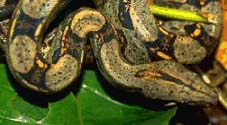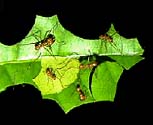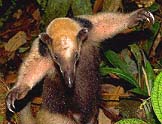Updated: 18 May, 2000
 continuation of...
Photo-Journey Through
a Costa Rican Rainforest
continuation of...
Photo-Journey Through
a Costa Rican Rainforest
The following half hour was uneventful. Then something moved just off the
trail and caught my eye
 as it slid beneath dead leaves. Suspecting a snake, I took a long stick and from a good distance gingerly moved the litter. Under the leaves, no more than two feet long, had coiled a baby boa constrictor.
as it slid beneath dead leaves. Suspecting a snake, I took a long stick and from a good distance gingerly moved the litter. Under the leaves, no more than two feet long, had coiled a baby boa constrictor.
Seeing any sort of snake is uncommon in a rainforest, and this was the first I spotted in days. Like other animals that rely on camouflage for protection, it remained motionless as long as I didn't disturb it. After a few quick photos, I left it alone.
 A short while later I reached the steep slope over the river, the end of the trail at the boundary of the reserve. Through the trees was the reward for those who walk the full length of the Platanillo trail: a spectacular waterfall pouring into a green canyon. Beyond lay unbroken, undisturbed rainforest.
A short while later I reached the steep slope over the river, the end of the trail at the boundary of the reserve. Through the trees was the reward for those who walk the full length of the Platanillo trail: a spectacular waterfall pouring into a green canyon. Beyond lay unbroken, undisturbed rainforest.
It was now close to eleven and time to return to the lodge for lunch so I turned back. Ahead, bits of leaves like green confetti dotted the ground,
 moving along an inch-wide trail leading to a mound of bare earth twenty feet to the right. I was stepping over a never-ending column of ants returning home with crescents of leaves held aloft.
I decided to make a detour. The oval mound, rising three feet above the ground, covered at least a hundred square feet. I had found the nest of millions of leaf-cutter ants.
moving along an inch-wide trail leading to a mound of bare earth twenty feet to the right. I was stepping over a never-ending column of ants returning home with crescents of leaves held aloft.
I decided to make a detour. The oval mound, rising three feet above the ground, covered at least a hundred square feet. I had found the nest of millions of leaf-cutter ants.
Now the air was noticeably warmer, my shirt damp with perspiration, and my thoughts increasingly fixed on a shower and getting into some dry clothing before lunch.
I walked straight back to the cabin. By the time I reached the lodge for lunch, I was renewed. The others were gathered around the steps to the dining room, checking the guidebooks and listing the birds they'd seen or heard on the morning's hike (black-chested hawk, collared trogon, tinamou, chestnut-mandibled toucan, ...). They recalled the troop of howler monkeys they had encountered and laughed about skidding in slopes of mud. Over a typical Costa Rican meal of chicken, salad, vegetables, rice and beans, they talked (in English, Dutch, German, and French) of where they lived, what they did at home, and what brought them to Costa Rica and Rara Avis. Over coffee, while others discussed which trail would be most productive for wildlife, I decided to heed the call of the hammock.
The shrill buzz of cicadas filled the mid-afternoon air. I returned to the cabin and, with a copy of Tropical Nature (Adrian Forsyth and Ken Miyata's superb introduction to neotropical rainforests) in hand, I slid into the hammock. When I awoke an hour later, the sky was clouding over. If I hurried, there was still time enough to walk the two miles to the Rara Avis butterfly farm and return before dark and I gathered my gear and set off down the slope.
I covered not more than fifty feet when I was startled by a rustle in the shrubbery almost at my feet. I froze and saw only a long, almost hairless tail. A moment later, as I backed up, a tamandua (a vested anteater) retreated from the undergrowth, its snout testing the ground for opportunity. It made its way lethargically to a small termite nest in the stump of a fallen tree and began to tear away at it. The tamandua was oblivious to my presence. Only after it heard me shift to reach my camera did it stand erect with nose held high to taste the air.
 Then, detecting my presence, it spread wide its hooked forepaws as if to invite a hug, in a characteristic defensive posture. Within a minute, concluding I posed no threat, it resumed its foraging, shuffling and sniffing into the forest.
Then, detecting my presence, it spread wide its hooked forepaws as if to invite a hug, in a characteristic defensive posture. Within a minute, concluding I posed no threat, it resumed its foraging, shuffling and sniffing into the forest.
I now thought better of hurrying through the woods and put off until morning the visit to the butterfly project. Here, I would sit for a while and take in my surroundings and whatever happened by. Perhaps after dinner I would put on my headlamp and take a night hike. But right now, the richness of the rainforest was intoxicating enough. With patient observation and quiet thought, it rekindled marvel and wonder. Surely that was a paltry price to pay for feelings so rare.
Dr. Sandy Wiseman is a forensic and educational psychologist, conservationist, photographer, and director of Conservation International - Canada. He organizes trips to rainforests for the University of Toronto and enjoys photographing wildlife, particularly rainforest creatures.
Although he grew up in Montreal, Sandy's love for wilderness blossomed in graduate school at Cornell University. He returned to Canada after completing his Ph.D. and now lives in Toronto where he devotes his spare time to biodiversity conservation and planning returns to the tropics.
Go to: Page 1, Page
2, or PlanetKeepers' home page
You may reproduce this work in electronic or hardcopy form
for any non-profit or "not-for-profit" purpose if you:
- Display the phrase:
"© 1995 - 1998 Sandy Wiseman <sandy.wiseman@utoronto.ca>"
at least once on each page where any of this work is used.
- Notify Sandy by e-mail that you are reproducing his work.
Profit-seeking organizations are required to
obtain written permission from Sandy Wiseman before they can reproduce or adapt any of this work in any form.
Sandy Wiseman's article was adapted to Web hypertext 21 October 95 by
Wayne L. Pendley.
All of the images on this page are original photographs by Sandy Wiseman, taken on site at the Rara Avis rainforest lodge and reserve in Costa Rica, edited by Wayne for better display over the Web.
EcoFuture ™ Comments to:
Fred Elbel
EcoFuture Home
 as it slid beneath dead leaves. Suspecting a snake, I took a long stick and from a good distance gingerly moved the litter. Under the leaves, no more than two feet long, had coiled a baby boa constrictor.
as it slid beneath dead leaves. Suspecting a snake, I took a long stick and from a good distance gingerly moved the litter. Under the leaves, no more than two feet long, had coiled a baby boa constrictor.
 continuation of...
Photo-Journey Through
a Costa Rican Rainforest
continuation of...
Photo-Journey Through
a Costa Rican Rainforest

